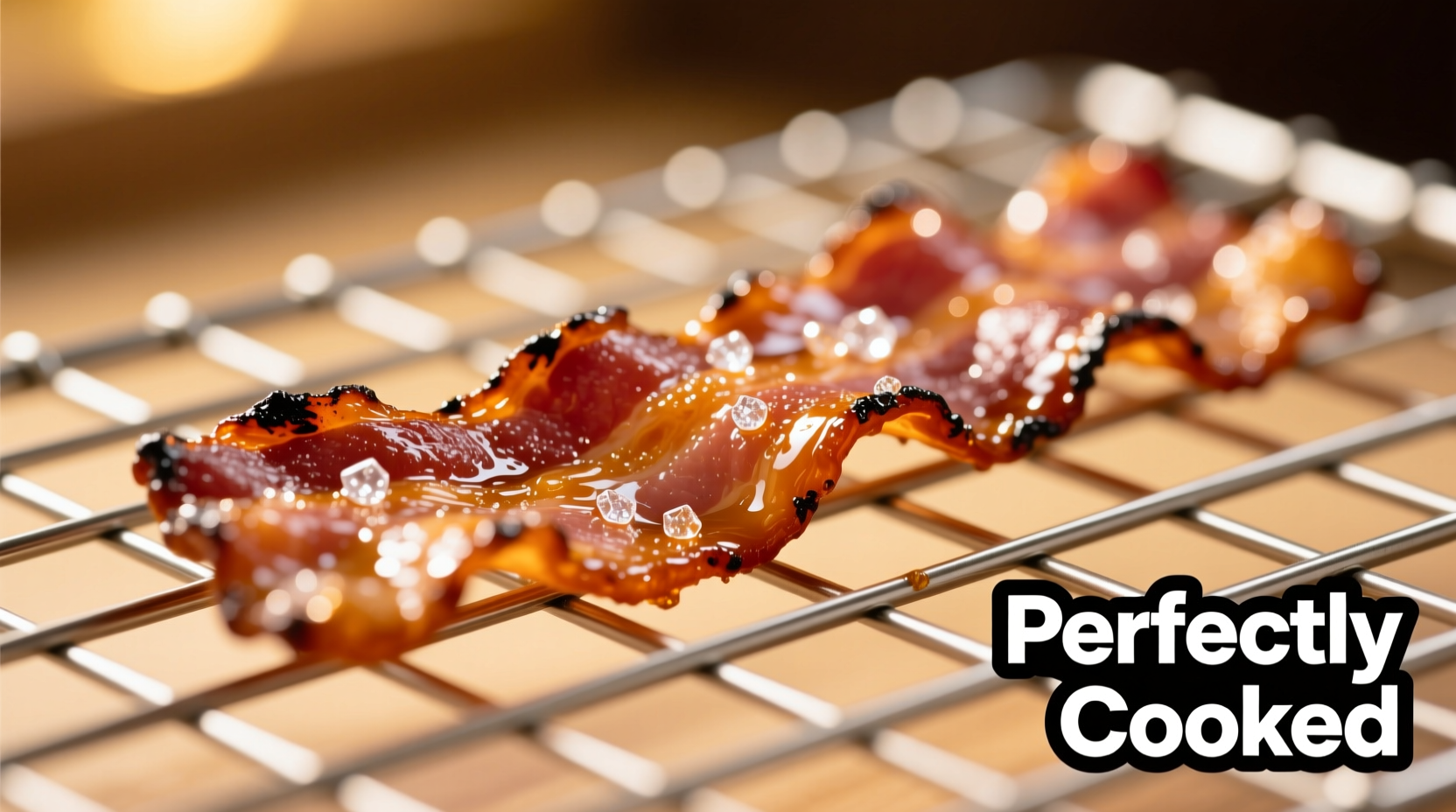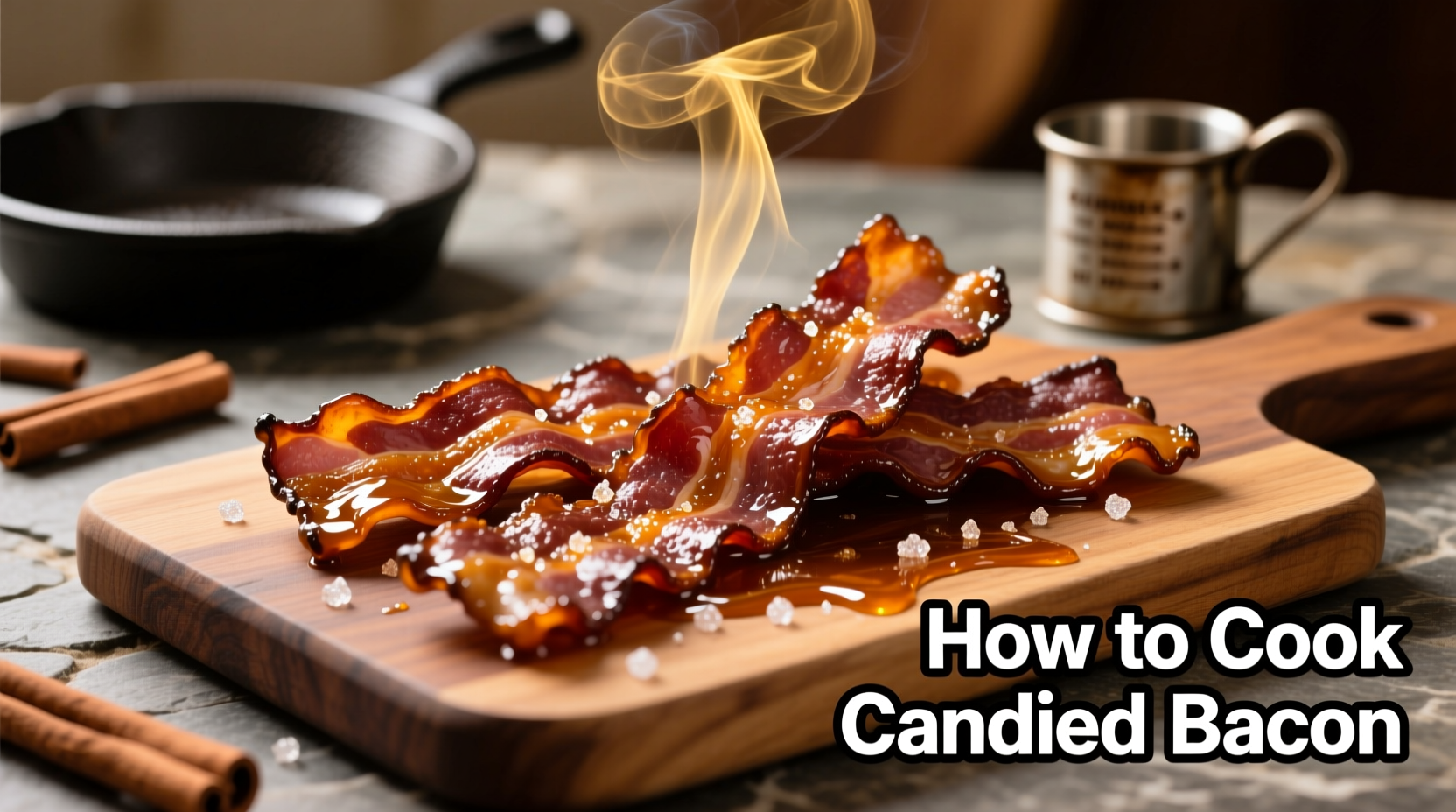Preheat your oven to 375°F (190°C), line a baking sheet with parchment paper, and arrange bacon strips in a single layer. Mix 1/2 cup brown sugar and 1 teaspoon black pepper, then evenly coat each strip. Bake for 15-20 minutes until crispy and caramelized. Cool on a wire rack for perfect candied bacon every time.
Nothing transforms breakfast or elevates a charcuterie board like perfectly cooked candied bacon. This straightforward oven method delivers crispy, sweet-savory strips with minimal effort and no risk of burnt sugar disasters. Professional chefs and home cooks alike rely on this technique because it consistently produces restaurant-quality results without specialized equipment.
Why This Candied Bacon Recipe Works
Unlike stovetop methods that require constant attention, the oven approach ensures even cooking and prevents sugar burning. The controlled heat environment allows the sugar to caramelize gradually while the bacon renders its fat properly. This method works for thick-cut or regular bacon, making it versatile for any occasion from weekend brunches to holiday entertaining.
Essential Ingredients and Equipment
Quality ingredients make the difference between good and exceptional candied bacon. Here's what you'll need:
| Ingredient | Quantity | Why It Matters |
|---|---|---|
| Thick-cut bacon | 1 pound | Holds up better to sugar coating and renders more evenly |
| Packed brown sugar | 1/2 cup | Creates the perfect caramelization without burning |
| Freshly ground black pepper | 1 teaspoon | Provides essential balance to the sweetness |
| Optional: Cayenne | 1/8 teaspoon | Adds subtle heat dimension for complexity |
Equipment essentials: Rimmed baking sheet, parchment paper (not wax paper), wire cooling rack, pastry brush (for optional glaze), and tongs for safe handling.
Step-by-Step Cooking Process
Preparation Phase
Line your baking sheet with parchment paper—this prevents sticking and simplifies cleanup. Arrange bacon strips in a single layer with space between them. For extra-crispy results, place a wire rack on the baking sheet before adding bacon. This elevates the strips, allowing fat to drip away for even rendering.
Mix your coating ingredients in a shallow dish: brown sugar, black pepper, and optional cayenne. The sugar-to-pepper ratio is critical—too little pepper creates cloying sweetness, while too much overwhelms the delicate balance.
Cooking Timeline and Temperature Guide
Candied bacon preparation has evolved significantly from its early 20th century origins. Originally made exclusively on the stovetop with inconsistent results, modern oven methods have standardized the process:
| Era | Method | Result Quality |
|---|---|---|
| 1920-1950s | Stovetop frying | Inconsistent caramelization, frequent burning |
| 1960-1990s | Broiler method | Better control but required constant monitoring |
| 2000s-present | Low-temperature oven | Perfect caramelization with hands-off cooking |
Preheat your oven to 375°F (190°C)—this temperature creates the ideal environment for sugar caramelization without burning. Lower temperatures prolong cooking and prevent proper crisping, while higher temperatures risk burnt sugar.
Application and Baking
Using tongs, dip each bacon strip into the sugar mixture, coating thoroughly on both sides. Shake off excess sugar to prevent pooling. Return coated strips to the baking sheet. For extra-glossy results, brush with a simple syrup mixture (1:1 water to sugar) during the last 5 minutes of cooking.
Bake for 15-20 minutes, rotating the pan halfway through for even cooking. The exact time depends on your bacon thickness and desired crispness. Watch for these visual cues:
- 5 minutes: Bacon begins to curl and render fat
- 10 minutes: Sugar starts melting and bubbling
- 15 minutes: Deep amber color with active caramelization
- 20 minutes: Crispy texture with rich caramel coating

Avoiding Common Mistakes
Many home cooks encounter issues with candied bacon due to context-specific limitations. Understanding these boundaries prevents frustration:
- Overcrowding the pan: Causes steaming instead of crisping—always leave 1 inch between strips
- Using melted butter: Creates soggy texture—the sugar should adhere directly to bacon
- High oven temperatures: Burns sugar before bacon renders—never exceed 400°F
- Skipping the cooling rack: Traps steam, making bacon soggy—always cool on wire rack
Professional kitchens avoid filler content by focusing on essential techniques. Skip unnecessary steps like pre-boiling bacon or using liquid smoke—these compromise texture and flavor authenticity.
Serving and Storage Recommendations
Candied bacon reaches peak crispness after 5-10 minutes of cooling on a wire rack. Serve immediately for the best texture, or store properly for later use:
- Room temperature: Keep in airtight container for up to 2 days
- Refrigerated: Lasts 1 week—re-crisp in 350°F oven for 5 minutes
- Freezer: Store in single layers with parchment between strips for up to 3 months
Pair with complementary flavors: crumbled over salads, wrapped around dates, or served alongside bourbon-glazed Brussels sprouts. The sweet-savory profile also enhances chocolate desserts—try crumbling over brownies or ice cream.
Troubleshooting Guide
Even experienced cooks encounter issues. Here's how to fix common problems:
- Sugar burning: Oven temperature too high—reduce by 25°F and check every 3 minutes
- Soggy texture: Insufficient rendering—extend cooking time by 5 minutes
- Uneven coating: Sugar not adhering—pat bacon dry before coating
- Bitter taste: Burnt sugar residue—clean baking sheet thoroughly between batches
Perfect Candied Bacon Variations
Once you've mastered the basic technique, experiment with these professional variations:
- Maple-candied: Replace half the brown sugar with pure maple syrup
- Spiced: Add 1/4 teaspoon cinnamon and 1/8 teaspoon cloves to coating
- Smoky: Use applewood-smoked bacon and add 1/2 teaspoon smoked paprika
- Gluten-free: Ensure bacon contains no malt vinegar or wheat-based ingredients
For special diets, substitute coconut sugar for brown sugar (note: caramelization differs) or use turkey bacon (requires reduced cooking time). Always check ingredient labels for hidden additives that affect cooking results.











 浙公网安备
33010002000092号
浙公网安备
33010002000092号 浙B2-20120091-4
浙B2-20120091-4